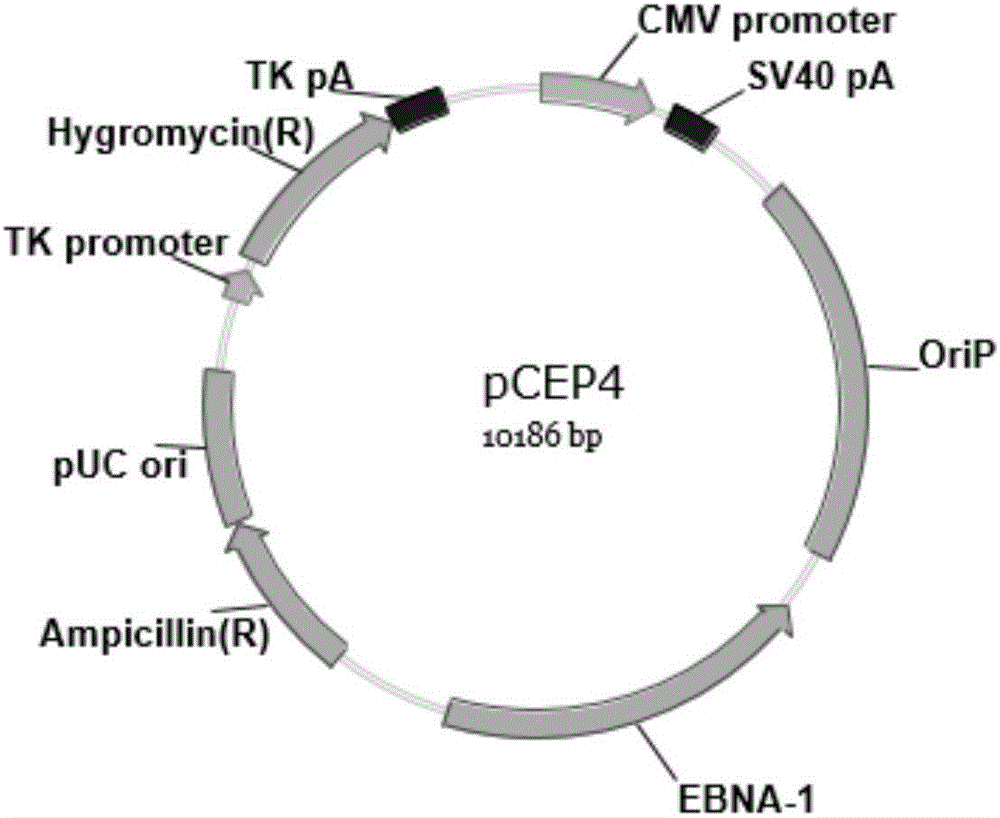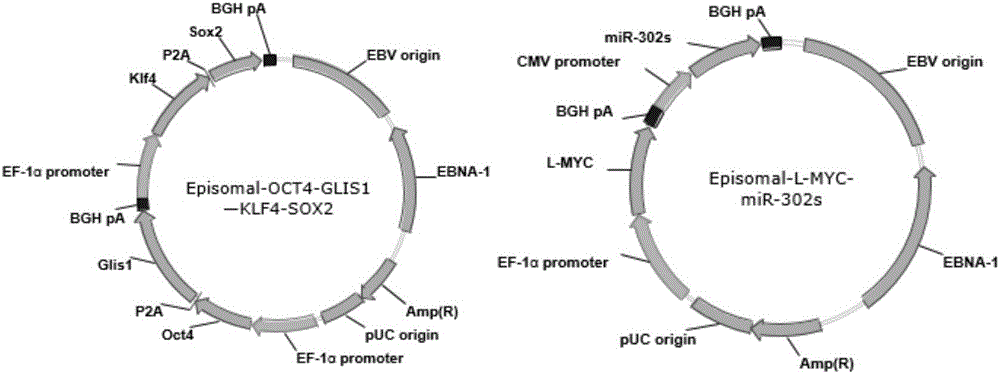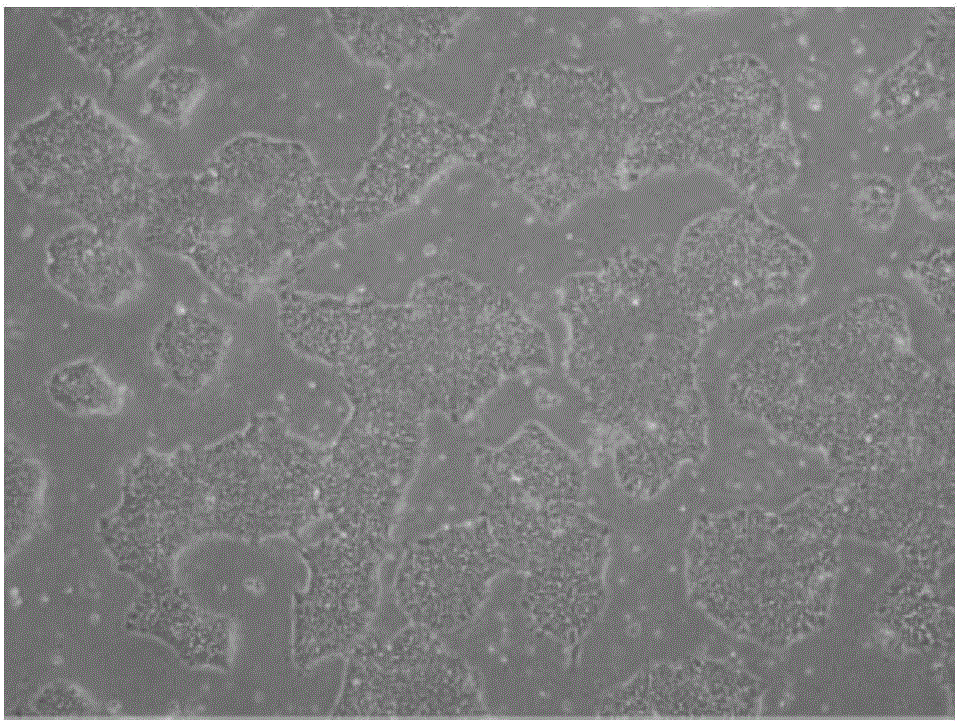Non-virus iPSCs induction composition and kit thereof
A composition and non-viral technology, applied in the field of bioengineering technology and regenerative medicine, can solve the problems of iPSCs cell tumorigenesis, achieve the effect of reducing clinical risk and shortening the induction culture time
- Summary
- Abstract
- Description
- Claims
- Application Information
AI Technical Summary
Problems solved by technology
Method used
Image
Examples
Embodiment 1
[0138] This embodiment 1 provides a non-viral iPSCs induction method, comprising the following steps:
[0139] 1) constructing DNA sequences expressing reprogramming factors OCT4, SOX2, GLIS1, KLF4, L-MYC and hsa-miR-302s into episomal plasmids to obtain recombinant plasmids;
[0140] Wherein, the hsa-miR-302s is hsa-miR-302cluster, and its sequence is shown in SEQ ID No.12;
[0141] Among them, the reprogramming factors OCT4 and GLIS1 are connected through the P2A co-expression element and use the EF-1α promoter to initiate transcription, and KLF4 and SOX2 are connected through the P2A co-expression element and use the EF-1α promoter to initiate transcription, and will contain OCT4, The DNA sequences of the four genes GLIS1, KLF4, and SOX2 were jointly constructed into an episomal plasmid; the reprogramming factors L-MYC and hsa-miR-302s were transcribed through the EF-1α promoter and the CMV promoter, respectively, and their The DNA sequence is constructed into an episomal ...
Embodiment 2
[0152] This example is based on Example 1. During the induction culture process in step 2), a small molecular compound is added to stimulate the induced reprogramming process.
[0153] A method for inducing non-viral iPSCs, comprising the following steps:
[0154] 1) constructing DNA sequences expressing reprogramming factors OCT4, SOX2, GLIS1, KLF4, L-MYC and hsa-miR-302s into episomal plasmids to obtain recombinant plasmids;
[0155] Wherein, the hsa-miR-302s is hsa-miR-302cluster, and its sequence is shown in SEQ ID No.12;
[0156] Among them, the reprogramming factors OCT4 and GLIS1 are connected through the P2A co-expression element and use the EF-1α promoter to initiate transcription, and KLF4 and SOX2 are connected through the P2A co-expression element and use the EF-1α promoter to initiate transcription, and will contain OCT4, The DNA sequences of the four genes GLIS1, KLF4, and SOX2 were jointly constructed into an episomal plasmid; the reprogramming factors L-MYC an...
Embodiment 3
[0161] This example provides a non-viral iPSCs induction method. In this method, in addition to the reprogramming factors OCT4, SOX2, GLIS1, KLF4, L-MYC and hsa-miR-302s, the inhibitory factors c-MYC, SV40- The effect of LT or TP53 on iPSCs to study the effect of different reprogramming factors on iPSCs karyotype.
[0162] Among them, c-MYC, SV40-LT or TP53shRNA were respectively constructed into episomal plasmids, or TP53 inhibitor TP53siRNA was directly transfected into somatic cells, or Pifithrin-μ or Pifithrin-αhydrobromide was directly added to somatic cells.
[0163] A method for inducing non-viral iPSCs, comprising the following steps:
[0164] 1) The DNA sequences expressing reprogramming factors OCT4, SOX2, GLIS1, KLF4, L-MYC and hsa-miR-302s were constructed into episomal plasmids as the control group, that is, group 1; on the basis of the control group, the Add the inhibitory factors c-MYC, SV40-LT or TP53shRNA to the episomal plasmid as shown in the table below or...
PUM
 Login to View More
Login to View More Abstract
Description
Claims
Application Information
 Login to View More
Login to View More - R&D
- Intellectual Property
- Life Sciences
- Materials
- Tech Scout
- Unparalleled Data Quality
- Higher Quality Content
- 60% Fewer Hallucinations
Browse by: Latest US Patents, China's latest patents, Technical Efficacy Thesaurus, Application Domain, Technology Topic, Popular Technical Reports.
© 2025 PatSnap. All rights reserved.Legal|Privacy policy|Modern Slavery Act Transparency Statement|Sitemap|About US| Contact US: help@patsnap.com



